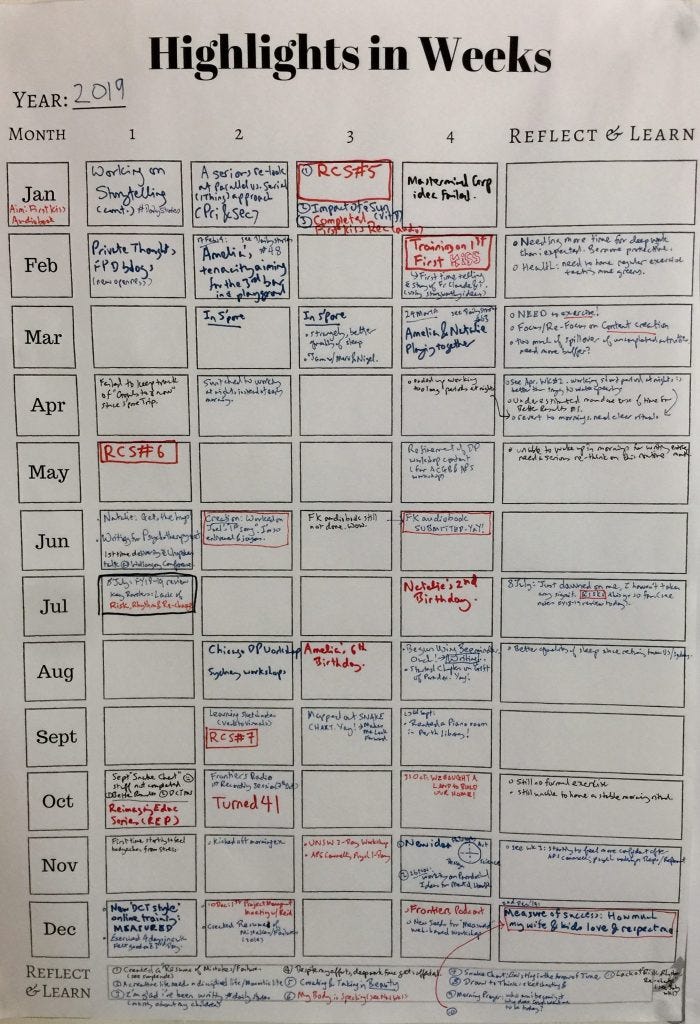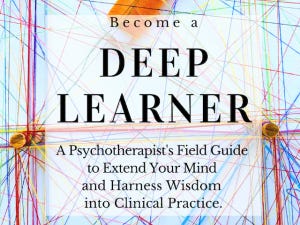Personal Learnings: Looking Back at 2019 in Order to Move Forward (Part II of II)
Updates by Daryl Chow, MA, Ph.D.(Psych)
View this email in your browser
Personal Learnings: Looking Back at 2019 in Order to Move Forward (Part II of II)
By Daryl Chow, MA, PhD on Mar 23, 2020 03:44 pm
(Update 20 March 2020: Like other countries, Australia has now instituted a travel ban. COVID-19 has impacted so many families directly and indirectly. My thoughts and prayers go out to you).
In the previous post, I talked about my resume of mistakes in 2019. Boy oh boy, what a humbling experience. More importantly, I’m really glad I’ve systematically capture errors, blunders and mistakes. This not only serves as a personal reminder, but it keeps me honest and on-track as I proceed each year in my endeavors. By intentionally looking back at them, it helps me to move forward with greater clarity.
(Turns out that the act of “Retrieval practice” has got more leverage in learning that constantly consuming a stream of information, or even simply “revising” old materials . This is one of the tenets we touch on the web-based workshop, Deep Learner. For more, click here ).
Guided by my mistakes and other learnings that i’ve stumbled upon through 2019, I’ve grafted 8 learnings that I’m taking with me in 2020 (and through the global pandemic).
I hope you find them useful as well.
GET YOUR HIGHLIGHTS IN WEEKS TEMPLATE!
1. A Creative Life Needs a Monastic Life
One thing that become clear to me as I looked back at my 2019 Highlights in Weeks is that I need to have a structure that facilitates focused concentration. In many ways, I view what I do in therapy, teaching, writing, music, and even parenting, as a creative act. Contrary to the conventional notion that creativity needs to be messy and unstructured, I find myself needing to have a “monk-like” structure, in order to delve into the messy nature of what I do.
Revisiting what I wrote on When Someone Says “I Lack Discipline…”, helped to jolt my memory. (My present self is grateful for my past self, which sounds smarter than I am).
So this year, I’m beginning to be more careful with my weekly routines (each weekday of the week, I wear different hats, such as Writer, Visioner, Manager, Teacher/Consultant, Practitioner), especially how I start my days. Lately, I’m also implementing a reflection about how I end each day (“How did I do today?”). I’d share this in 2021’s version of Highlights in Weeks.
2. The Pay-Off of Writing Daily Stories
I have been capturing my own weekly learnings in clinical practice for some years now. Last year, I also began to capture “Daily Stories,” that is, stuff that happens that I want my future self to remember.
So far, I ended up with 145 daily stories. Far cry from it being “daily,” but even now when I read these entries, I am so glad I did.
As it turns out, these daily stories that I’ve captured are mostly about my kids.
Here’s 2 samples of my “daily stories”:
125. “Where are we?”
16nov19
Driving in subiaco after home base building, going for dinner. In the car,
Amelia asked “Where are we?”
Her 2 yr old sister says, “Here.”
90. “Mama, tell me the truth, did Papa’s plane crash into the
ocean ?”
8th of june 19
(Relayed to me by my wife)
My flight from Sydney to Perth got delayed die to fog . wife and kids
coming to pick me up. delayed further. Amelia asked Liqin , “Mama, tell
me the truth, did Papa’s plane crash into the ocean ?”
All we have are stories. I hope that these stories will linger in our retelling years later. (Hat tip to Matthew Dicks for his idea of capturing daily stories. He called it “Homework for Life.” He’s also a teacher).
3. Creating and Taking in Beauty
I had two realisations.
The first was, based on a question, “what do I want to create?”[1]
I realised that if I keep climbing the ladder of abstraction, what I want to create is beauty in my life. [2]
Beautiful experiences for others, be it in therapy, teaching, or art.
This came full circle for me when I stumbled on an old piece of writing I did on April 22, 2005 titled, A Piece of Heaven. (Again, my past self is sound smarter than I am).
My second realization was, in order for to “create beauty”, I need to be observant and learn to see beauty.
In order to do that, try as I will, I can’t go at the speed of light, but instead, I had to travel at the speed of light. We see things differently when we slow down. I’m now trying to walk and cycle more.
4. Snake Chart: Existing in the Arrow of Time
In my 2018 version of Highlights in Weeks, I talked about needing to work on stuff in Series vs Parallel (See point #9). In gist, this literally means that I should work on only 1 key project at a time, instead of straddling 4-5 various projects at a time.
At the end of 2019, I took this idea one step further and designed what I call a “Snake Chart” in my home office. Basically, imagine a huge A1 sized snake and ladder, which only 12 steps, each step representing one month. And in each month, I’m only allowed to work on ONE key project. Since each project is written on post-it notes, it’s adaptable.
But the cool thing is that it’s VISIBLE. When it’s visible, it’s inescapable from my attentional field. This orients me to not only way I’m going, but where I’ve been and where I am currently. Quiet literally, it gives me bearings.
(For more about the image of making valuable stuff visible, check out this Frontiers Radio podcast on The Dyson Vacuum Cleaner).
5. Draw in Order to Think Clearly
In 2018, I realised how writing became so integrate for me. Writing was not a way to write what I know, but it’s more of like “writing in order to know.”
In mid 2019, I began to doodle in sketch noting. I learned as much as I could, especially for professional sketchnotes like Dan Roam and Doug Neil.
And then I discovered that from a neurological perspective, we have what we call a dual coding pathway. We encode information phonologically and visually; both pathways DO NOT interfere with each other. Instead, when we optimise using dual coding, we learn deeper and better!
On the flip side, this is why when someone is presenting at a workshop while showing a slide with too many words, we switch off listening to the person and read the text on the slide deck. But, if you optimise using the dual coding principle, you would talk, and show slides with less to no words, and more images.
Given this, I often find myself wondering “how to use words that create images in a person’s mind” and “how to use images that bring meaning words in a person’s mind.”
I have since began taking the courage to doodle, sketch and symbolise stuff in sessions with my clients. It’s amazing how clients remember the visuals, and not my so-called wicked wise words!
See my attempts at live sketchnoting in this video on Reimagining Education in Psychotherapy. It’s nowhere near as professional as I would like, but it’s a start.
Dual coding has huge implications when you are learning something new. I talk about this in the Deep Learner web-based workshop.
6. Morning Meditation
This relates to point #1.
I struggled to get on a morning routine, besides trying to rush my older child for school.
I stumbled upon an anchor in a form of meditative prayer that I start my day with, simply by asking myself,
“Who am I becoming?”
“What does God asks of me today?”
For some reason, this grounds me.
Perhaps from a secular perspective, it’s useful to ask what Viktor Frankl says, “What does life asks of me?” We simply need to drill it down to “What does life asks out of me today?”
#7. Struggle is a Teacher
Deep work time keeps getting affected. There were so many times in 2019 that I got so pissed with myself. One of the main reasons was that I couldn’t delve deeply into stuff that I was working on, be it a book project, developing the Deep Learner course, deliberate practice efforts, etc.
All of this was going on while trying to stay engaged as a family man.
Things got so bad that in the first week of Nov, for the first time in my life, I developed strange body aches and joint pains. I knew it wasn’t an early onset of geriatric experience. My body was speaking—no, screaming—for me to take heed. It was around Nov-Dec that I started to seriously consider the notion of re-developing better daily rhythm and recovery. [See previous post, Part I: Personal Mistakes.) No mind over body stuff. I believe the mind is there to take care of the body. Thankfully, I’m a lot better now.
8. My Measure of Success
My final point is about the big picture. Some time in Dec 2019, I was revisiting a book written by Clayton Christensen, who incidentally passed away January this year. The book was called How Will You Measure Your Life.
What am I doing with my life? I’d have probably only have another 40 or so more of these Highlights in Weeks to fill out…
As I pondered on this, my measure of success is based on:
how much my wife and kids love and respect me.
It sounds cliche, but some cliches are true most of the time.
This keeps me honest and not lose track. I’m a self-employed, single income earner in the family, and this puts sort of a weigh on me, but I need to continually re-member and pay close attention to my metric of success, of what a fruitful life would be. I don’t want to be someone who is highly successful as a therapist and teacher, but a grouchy monster in the eyes of my wife and kids. I rarely worry so much of what others think of me, but these 3 people are some of the very few people that their opinions are like beacons. Looking through their eyes offer a glimpse of getting over myself.
Perhaps it’s less about success and more about fruitfulness.
I want to travel lightly.
There you go. My eight extractions of learnings from all the blunders, bloopers and highlights from looking back at 2019.
What were your key learnings from 2019, pre-COVID-19 era? Love to hear from you in the comments below.
(If you are posting for the first time, it might not appear in the comments immediately. I will read them and approve them, unless it’s a spam!).
If you are interested in using the Highlights in Weeks (HIW) template and use it for your own reflection, you can download it here. Print this out on at least an A2 sized so that you can write in it. In Australia, I printed it at Officeworks and it costs about #2.
GET YOUR HIGHLIGHTS IN WEEKS TEMPLATE!
Footnotes:
[1] inspired by Robert Fritz writings in The Perth Of Least Resistance.
[2] The word beauty started to open up my perspective after reading John O’ Donahue’s book, Beauty.
Photo by Edi Libedinsky
The post Personal Learnings: Looking Back at 2019 in Order to Move Forward (Part II of II) appeared first on Frontiers of Psychotherapist Development.
For Best Experience, Read in browser »
Recent Articles:
Personal Mistakes: Looking Back at 2019 in Order to Move Forward (Part I of II)
No More American Idol
The Language of Inner Life
Myths About Myth
You Haven’t Taught Until They Have Learned







